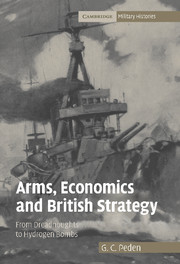Book contents
- Frontmatter
- Contents
- List of tables
- Acknowledgements
- List of abbreviations
- Introduction
- 1 The dreadnought era, 1904–1914
- 2 The First World War
- 3 Retrenchment and rearmament, 1919–1939
- 4 The Second World War
- 5 The impacts of the atomic bomb and the Cold War, 1945–1954
- 6 The hydrogen bomb, the economy and decolonisation, 1954–1969
- Conclusion
- Select bibliography
- Index
5 - The impacts of the atomic bomb and the Cold War, 1945–1954
Published online by Cambridge University Press: 16 July 2009
- Frontmatter
- Contents
- List of tables
- Acknowledgements
- List of abbreviations
- Introduction
- 1 The dreadnought era, 1904–1914
- 2 The First World War
- 3 Retrenchment and rearmament, 1919–1939
- 4 The Second World War
- 5 The impacts of the atomic bomb and the Cold War, 1945–1954
- 6 The hydrogen bomb, the economy and decolonisation, 1954–1969
- Conclusion
- Select bibliography
- Index
Summary
Introduction
For the purposes of military technology, the post-war period may be divided into an atomic phase and a thermonuclear phase, the latter beginning with the Americans' first hydrogen-bomb tests in 1954. This chapter deals with the first phase. As international relations came gradually to be dominated by the Cold War, British foreign policy aimed to co-operate with what Churchill in 1948 called three overlapping circles of ‘free nations’: the United States, the Commonwealth and Western Europe. Anglo-American relations were the most important for three reasons. First, Britain had merged her atomic research with America's in 1942 and had hopes of collaboration in the post-war period. Second, Britain had to borrow dollars to finance imports from North America while converting her industries from war to peace, and she hoped to co-operate with the United States in creating a stable and expanding international economy. Third, only the United States could counter-balance the power of the Soviet Union.
In analysing defence policy after 1945 one has to remember that the course of international relations was not predictable. An important Foreign Office brief for the Potsdam conference in July 1945 recommended that Britain should stand firm diplomatically against Soviet designs, but did not assume that American support would be forthcoming, and concluded that Britain must base its foreign policy on the principle of co-operation between the United States, the Soviet Union and the British Commonwealth.
- Type
- Chapter
- Information
- Arms, Economics and British StrategyFrom Dreadnoughts to Hydrogen Bombs, pp. 229 - 271Publisher: Cambridge University PressPrint publication year: 2007



